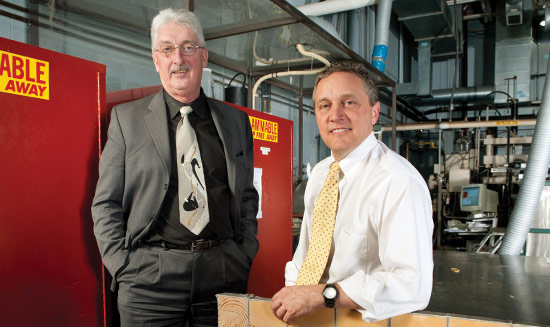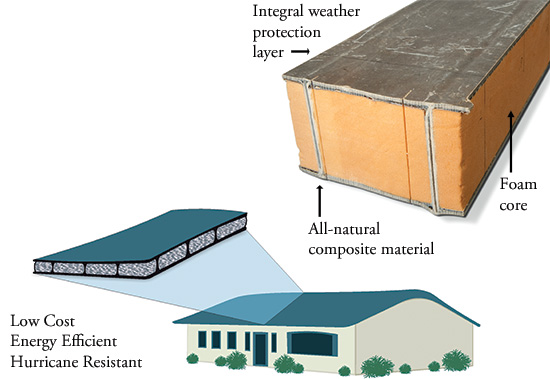
By karen b. robertsCollege of Engineering

The earthquake that devastated Haiti in 2010 rendered more than 1 million homeless and collapsed or severely damaged 250,000 residences and 30,000 commercial buildings, according to Haitian government estimates.
National Hurricane Center reports estimate the property damage caused by Hurricane Katrina along the Gulf coast in 2005 at $81 billion.
A prevailing question following such disasters is can this type of damage be prevented?
At the University of Delaware, Tripp Shenton and Richard Wool have been a driving force behind the development of advanced roofing materials designed to withstand such natural catastrophes.
Shenton is a civil engineer with more than 25 years' expertise in structural health monitoring and condition assessment of civil infrastructure. Eight years ago, he began collaborating with Wool, a chemical engineer and materials scientist who develops novel composites using green, renewable materials.
"I've always been interested in using alternative materials for civil infrastructure applications," explains Shenton, chair of UD's Department of Civil and Environmental Engineering. "Civil engineers are not building rocket ships, but talking with Richard sparked the idea of developing a better, safer roofing system for low-rise construction using renewable materials."
In conventional construction, an average neighborhood roof is built from rafters, trusses, sheathing, tar paper and shingles. Under high winds, these materials easily "peel off," creating holes that impair structural stability to the roof and ultimately to the home, and can lead to structural collapse, says Shenton. Even small holes present large problems because they pressurize the interior of the home, opening the structure to wind and water damage.
"Houses deconstruct in high velocity wind due to pressure drop," adds Wool. "The roof acts like an airplane wing, which uses the pressure drop to guide the aircraft. While the drop is only about one psi (pounds per square inch), it is the equivalent of hanging a Volkswagen bus off of each 4' x 8' board on your roof."
Superior structural stability, renewable resources
To address this problem, Shenton and Wool conceived the idea of replacing the common patchwork of individual roofing components with a monolithic panel that acts as one large structural unit and expands in high winds.
Their design, funded through grants from the National Science Foundation, is called a "sandwich structure." The outer layers (Wool calls this "the bread") are made from recycled paper infused with a biobased resin made from thin, high-performance composites. The interior layer (or "meat") is 12 inches of synthetic based foam core, which offers inherent insulation. The "sandwich" is bonded with bioresins that act as an impermeable weather coating, provide superior structural integrity and improved disaster resistance, and resist holes, cracks or fissures that can degrade the roof.
When installed, the all-natural composite roof system works together with the floor and the vertical walls to transfer the loads coming at it from the weather to preserve the building envelope and reduce the loss of life and property damage due to hurricanes and earthquakes.
The soy-based natural-fiber composites are environmentally friendly and inexpensive relative to petroleum-based composites. The resins are derived from a plentiful U.S. crop — the soybean — while the natural fibers are byproducts of seasonal crops that otherwise would become waste.
Because the monolithic roof system can be mass produced in a factory and assembled at the site, the potential exists to also reduce construction site injuries.
"This particular design offers a much needed four-way punch. It is low-cost, energy efficient, made from renewable resources and contains fabulous engineering properties that impart disaster resistance in an efficient and environmentally friendly way," says Wool. He is currently working to commercialize a biobased foam made from soybean for added energy efficiency.
A New York architect has used a modified version of the UD system to design "disaster houses in a box," which could be rapidly deployed in the thousands by the Red Cross to provide relief from future earthquakes, tsunami, floods, hurricanes and other natural disasters.
UD green engineering students have examined the design for Haiti reconstruction projects, an option Wool says is being considered for the future by Catholic Relief Services in Baltimore, Md.
From a global warming perspective, the hurricane-resistant design is highly energy efficient and, if combined with solar energy, could make an important contribution to our global energy, according to Wool. Because it is made with biobased materials, carbon trading benefits also exist.
These attributes attracted the attention of the South African government, which recently signed a "memorandum of understanding" with UD to explore this technology to build 2.2 million low-cost township houses in South Africa.
With patents on the materials, Wool is currently working with industry partners, including UD startup Crey Bioresins Inc. and Dixie Chemical Company Inc. in Pasadena, Texas, to license and commercialize the technology in the Gulf States and elsewhere.
"It is a revolutionary technology, one that is almost before its time because the infrastructure is not yet there to produce it," concludes Wool. — Karen B. Roberts
Shenton and Wool's idea is to replace individual roofing components with a monolithic panel that expands in high winds. The "bread" in the sandwich-like structure is recycled paper infused with a biobased resin. The "meat" is 12 inches of insulating foam core. Bioresins bonded to the "sandwich" provide weather-proofing and superior structural integrity.
